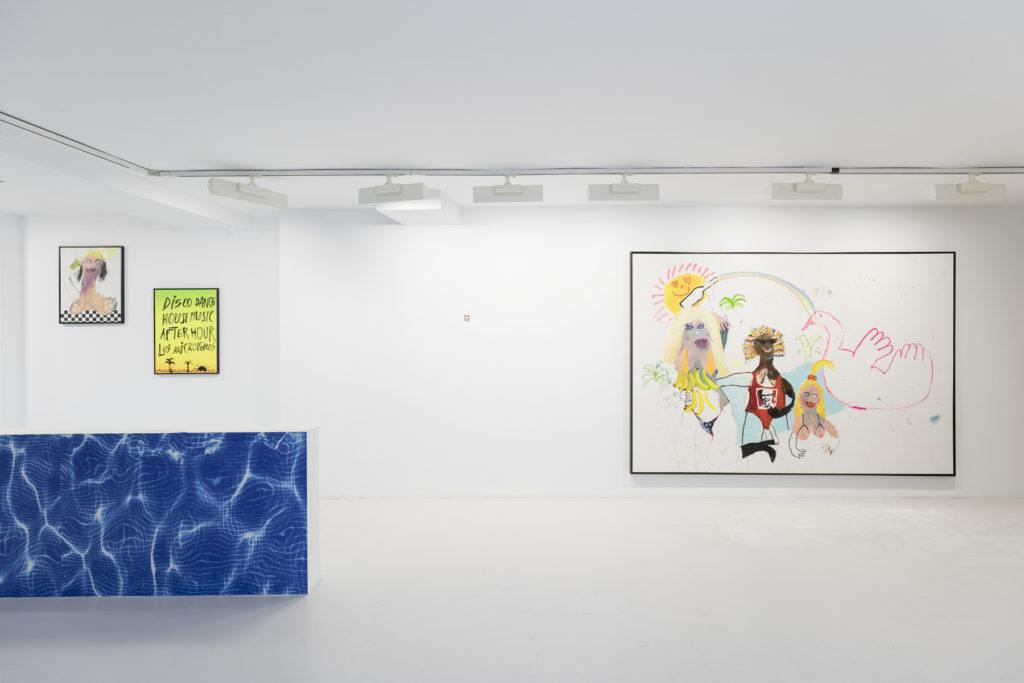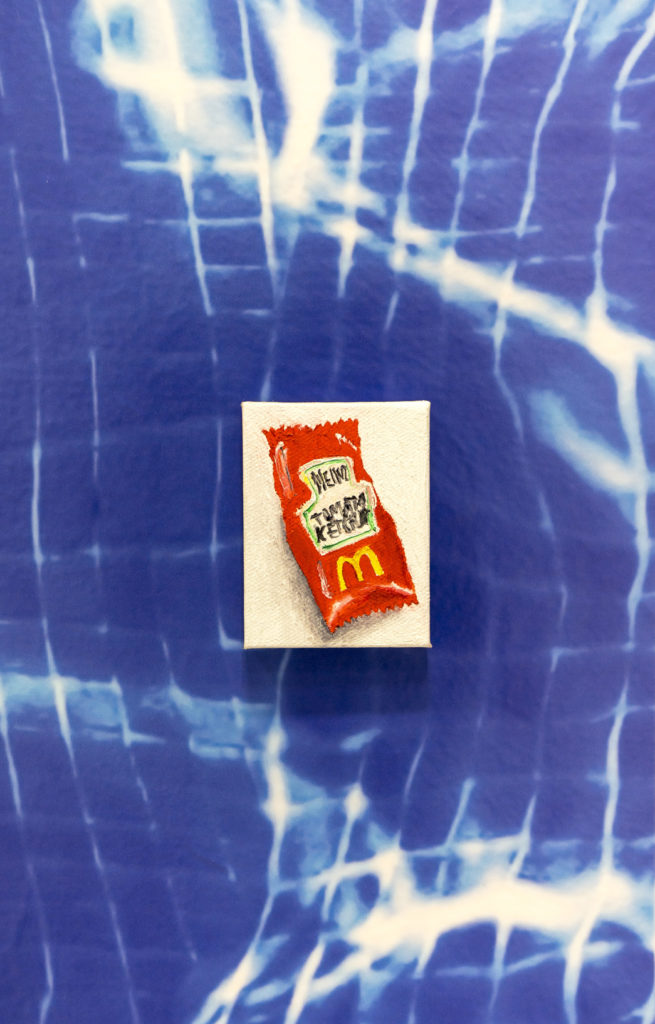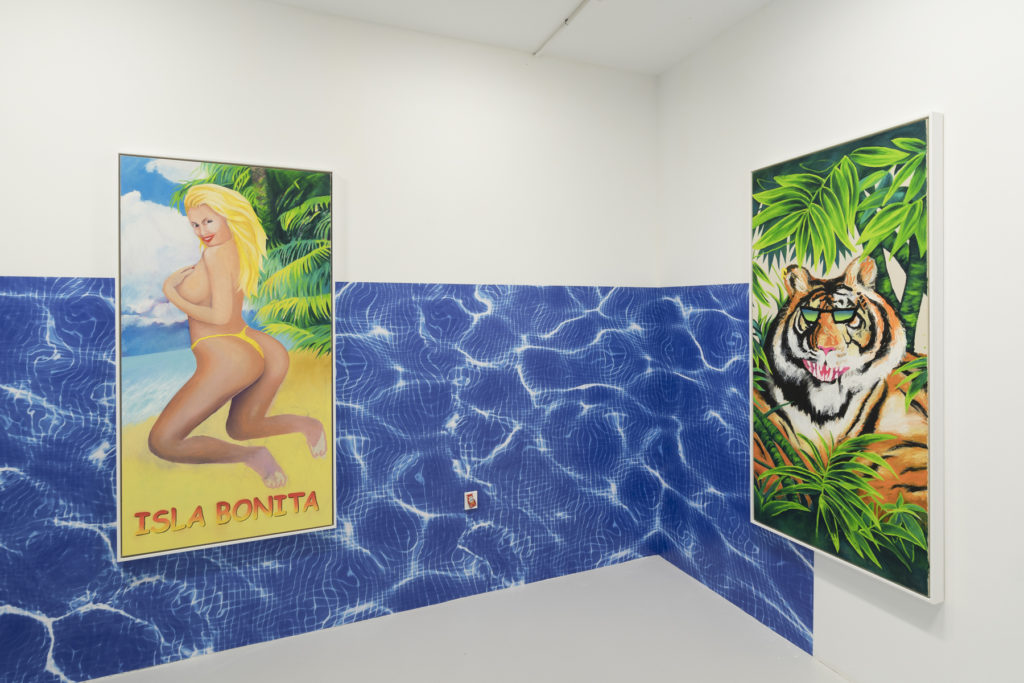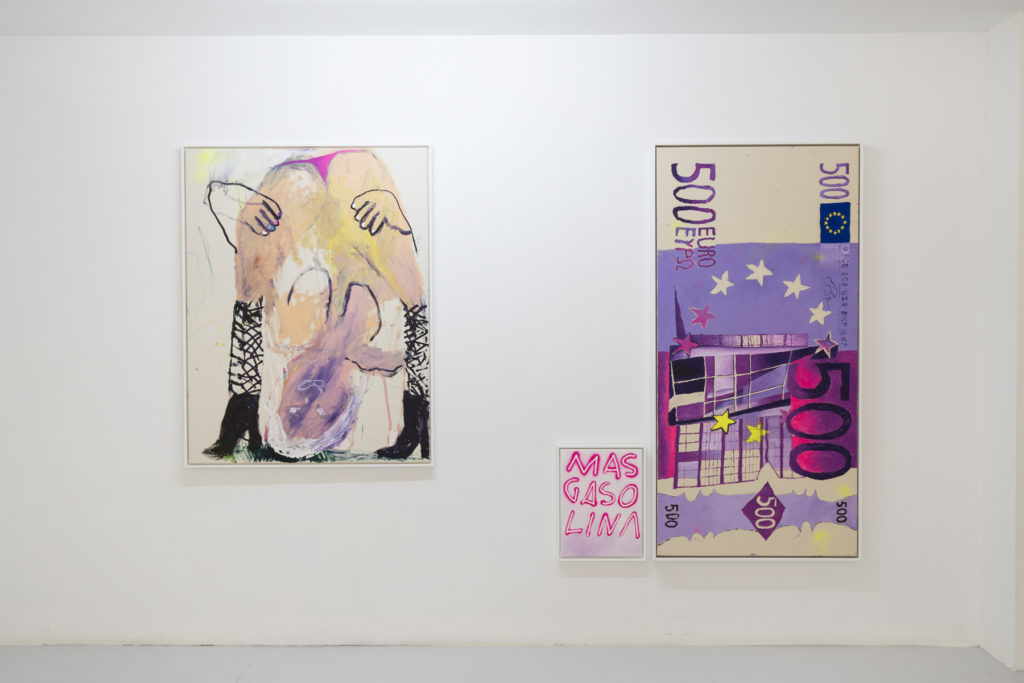ISLA BONITA
Galería Fran Reus
Palma de Mallorca, Spain
2019





















Isla Bonita
(Translation of original text in Spanish written by Tolo Cañellas)
In her first individual exhibition at the Fran Reus gallery, the artist Bel Fullana (Mallorca, 1985) continues to show us her own universe that she carries as a flag and that wild attitude without intending it, simply, she is like that. The beautiful island in which she lives, is her source of inexhaustible inspiration, specifically, that kind of tourism that arrives and whose only goal is to have fun, without taking into account (in fact, they do not care or care) where they are and where that possibility of an island becomes the reality of a theme park. Unleashing his joie de vivre, a French expression that refers to the joy of living, the enjoyment and the exaltation of the spirit, without questioning or entering into moralizing judgments. Everyone can do with own life what we considers convenient and enjoy it, it is a valid option like any other.
Hordes of reddened bodies, delivered to the wildest hedonism, understood from a juvenile point of view and related to moments of holiday leisure, are thrown into the eager pursuit of party, alcohol and rampant sex at any time of day and night. So, Fullana doesn’t judge, but filters and describes, always in a humorous and caricatured way, that particular type of low-end visitor, that white trash that we deny but at the same time venerate for being the source of a (supposed) economic prosperity, which become part during the summer season of the bizarre panorama of those specific environments in which the “anything goes” is the main motto.
“As a native, a spectator and a resident of Mallorca, I review the imaginary that fills the spaces inhabited by these newcomers to the island. His stay will take place in a kind of universe parallel to it, where everything is artificial and ephemeral and in which social relations are established with an expiration date” says Fullana.
On this occasion the artist unfolds in two, a kind of artistic bipolarity: on the one hand there is the classical (for known) and on the other, the artificial (because she does not recognize herself, but needs to be). The classic, call it Dr. Bel, makes the paintings to which we are usted to, with distorted environments, parodic abstractions, aggressive but unstable tracing, made, mostly with his left hand (without being left handed), unfolding in a shameless way and amoral. The other, call it Miss Fullana, makes a series of paintings much more realistic (we can speak of fullanesque realism), in this case, reproducing the typical towels of poor quality made in China, with random images, signed with the word Mallorca that we can find in any souvenir shop, as well as globalized food dishes, whose stock images can be used in any beach bar in the world, regardless of the final product served (expectation vs. reality) Palm trees? Tigers? Tropical fruits? Burgers? Dolphins? Sexy girls in top less? Pizza portions? Yes, everything and nothing at the same time. It also develops a series of paintings in mini format at real size of some of the typical objects that these visitors use: a lighter, an envelope of ketchup, a euro or a lipstick. No matter the context, only the experience that it provides. All a recurring list of clichés that mitify these environments being redundant and satirical, which have become the scene that welcomes the ethy and picturesque behavior of the passengers who occupy them.
“It is a description of the landscape that surrounds all this situation and that does not belong to the reality of the territory, but belongs to a larger reality, to the longing for revelry, sun and beach that is repeated in a multitude of places where have the optimal conditions to host a tourism of these common characteristics. No matter the point of the globe on which this site is located, all share a similar imagery, “says the artist.
All this (im) possible atmosphere, posed by the artist, is staged through a montage as an installation, recreating in a synthetic and artificial way a landscape place-no place, turning it at the same time into a kind of set inside another greater where the public itself acts as a tourist.
Text by Tolo Cañellas
Island Time!
(or, Perfect Place to Rest With Family and To Get Drunk)
Looking for a holiday getaway? The internet is bullish on the Spanish island of Mallorca, currently enjoying 4.6 out of 5 stars on Google. “The people are friendly, they know that most of their income based on the tourism [sic],” writes one reviewer. A Polish critic named Piotr concurs: “Perfect place to rest with family and to get drunk!!!” I’ve never been to Mallorca, but a few hours of laptop tourism has my curiosity piqued. What New Yorker is immune to the siren song of frictionless relaxation? But dig a little deeper and a less pleasant picture emerges. Recently, local authorities have decided to address a tourism-fueled epidemic of public boozing. It’s an unsurprising problem considering that RyanAir offers a direct flight from London to Mallorca, clocking it at just over two hours, for around $100. “Officials believe the limitless supply of alcohol at all-inclusive hotels has contributed to a rise in crime and dangerous crazes like ‘balconing’,” the UK’s Express noted, “which involves people jumping from balcony to balcony, often while drunk.”
No matter how cheap, warm, and vodka-soaked a place may be for weekenders, it’s impossible to fully erase its permanent residents. The locals may exist in the background, or as part of the vast infrastructure required to support a tourism economy, but they’re never fully effaced. Bel Fullana-who was born on the island in 1985, and still lives and works there- is one such local, and her paintings capture what it’s like to be a bystander in a culture of transient pleasure. “There are no longer hidden beaches”, she says, and mobs of visitors are “destroying the environment and the essence of the island. We always associate paradise with a deserted island, white sand, crystal-clear beaches. But in the summer the Mallorca beaches are really a hell; something precious turns into a nightmare. For me, paradise is not the environment, but the state of mind you’re in”.
The good news is that this seasonal revelry is confined to certain zones. “The tourists that arrive looking for crazy parties are concentrated in specific places”, Fullana explains, “and it’s in those places where you can really do a sociological study. These places don’t represent the island at all; they are a kind of parallel universe turned into a theme park. And it is there where the island is most destroyed, the tourists are so drunk that they don’t respect anything, they dirty everything, the beaches are flooded with garbage. It’s terrible to see it. I inspire myself with the pathetic essence of these places to create my work and in doing so I do not do it as a criticism, but as a way of showing the environment in which I live.”
What does it mean to be a witness in so-called paradise, or paradise lost? As curator Tolo Cañellas puts it, the artist “doesn’t judge, but filters and describes…that particular type of low-end visitors, that white trash that we deny but at the same time venerate for being the source of a (supposed) economic prosperity”. Fullana’s Mallorca is a place where party animals puke rainbows. Humans and animals are “happy” to the point of derangement. Women suntan in the nude, surrounding by a bounty of fruit and endless Marlboro Reds. Bodies are engines for obsessive consumption: more cigarettes, more junk food, more stimulus. “Pool party” (all works 2019) offers a cruel schematic. A blonde woman, on all fours and naked save for a G-string, open her mouth to swallow a rainbow that’s spurting from one of the faceless poolside partygoers; in return, she farts a heart. It’s a cycle that could continue indefinitely, until the music stops.
Fullana’s style is aggressively raw; incompleteness can be a goal in and of itself. While the artist does find a kinship with artists like Bjarne Melgaard, Jonathan Meese, and Paul McCarthy, “what I like more than anything else is the way that children paint and draw”, she says. Often, as in “The foxy sister”, we find sketchy alternative compositions beside the finished forms, as if the artist had simply called it a day without deciding which version she prefered. Her faux-naif renderings of faces, horses, or landscapes present a Skittles-bright facade, but that’s pure decoy. Like Robert Nava or Austin Lee, Fullana exploits the disjunction between colorful innocence and lurking subtext; stare too long at these paintings and the sadness seeps through, so many wasted white people smashing their naughty bits together. It’s always sunny, but the threat of hangover is a heavy cloud overhead.
As a whole, “Isla Bonita” uses debased images of pleasure to mount a critique, one that calls outsiders to account for reducing a complex place to a series of dumb signifiers: beaches, pineapples, palm trees. I’m reminded of Puerto Rican artist Radames Juni Figueroa’s “tropical readymades” and sculptures that digest and (re) present Carribean cliches, from local window blinds to coconuts and plants stuffed into basketballs and sneakers. “Isla Bonita” also brings to mind 2012’s Spring Breakers – an art film disguised as a mainstream popcorn flick starring James Franco and Selena Gomez. Harmony Korine leverages a slik, MTV aesthetic to tell a story that is ultimately about the emptiness of paradise. Likewise, Fullana’s decision to render her characters on the verge of dissolution – so happy they could literally burst – underscores a spiritual bankruptcy. Drunk and driftless, all they can do is sprawl out like beasts in the sun, endlessly saying “Hola” Their wide-eyed bacchanal seems like less of a let-it-all-hang-out spree and more like a burden they are doomed to repeat.
The sense of bitter irony sharpens further with two works in the show based on airbrushed beach-towel motifs. “Palote sunset beach towel” shows a couple knee-deep in the water, embracing in the golden hour beneath a palm tree. Their duck-puckered lips don’t quite meet; an oversized safety pin appears to be cinching their genitals together. Fullana’s usage of the palm tree itself, as a sort of shorthand for “tropical pleasure”, recalls Josh Smith and Sigmar Polke’s similar, serial paintings of the same motif. Through repetition, the palm tree hollows out, operating as a vague symbol for the good life. Meanwhile, Palote sunset beach towel’s true subject is the invisible infrastructure that makes possible its saccharine sunset embrace.
And yet it would be a mistake to view “Isla Bonita” as nothing more than a sour, puritanical attack on poorly behaved tourists. If Fullana excels at painting a certain type of hot mess – the budget traveler sucking down complimentary G&Ts while slathering on tanning oil – she does so by reveling in the hot mess of painting itself. Fullana is on a metaphorical holiday, taking time off from the rules of ‘polite’ painting. Here, at least, getting sloppy is a virtue; this is a portrait of the artist drunk on the medium’s gestual immediacy and jittery energy.
Scott Indrisek. Brooklyn, New York. May 2019